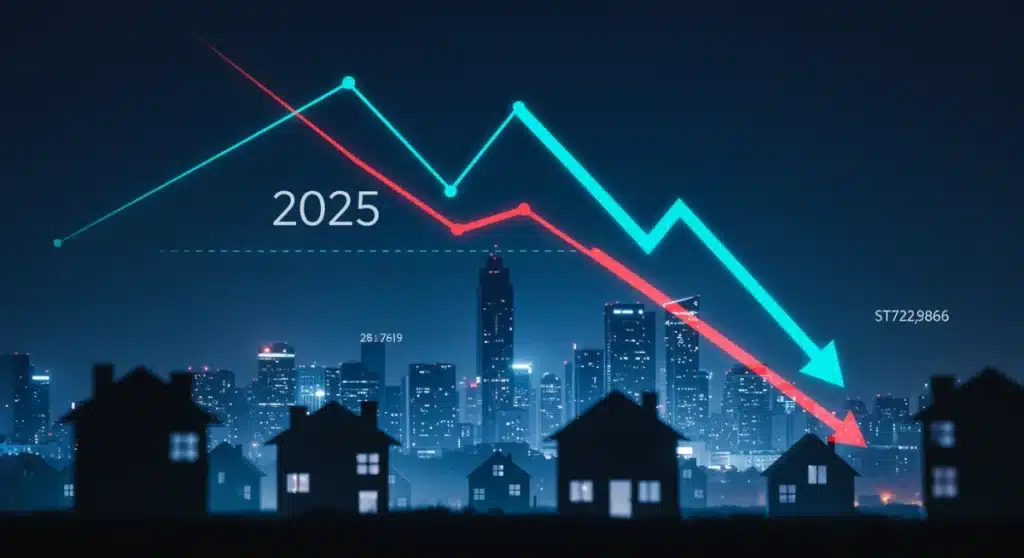Decoding 2025’s Real Estate: Expert Predictions & 7% Correction

Expert predictions indicate a potential 7% correction in the real estate market by 2025, signaling significant shifts for homeowners and prospective buyers.
Recent analyses are strongly suggesting that Decoding 2025’s Real Estate: Expert Predictions for a 7% Market Correction and What It Means for Homeowners is becoming a critical topic. What might this mean for your property and future investment plans?
Understanding the 2025 Real Estate Market Outlook
As 2024 progresses, real estate experts are increasingly pointing towards a significant shift in the housing market come 2025. Projections from leading financial institutions and real estate analysts suggest a potential 7% market correction. This forecast is not merely a prediction but an informed assessment based on prevailing economic indicators and historical patterns.
The term ‘correction’ often sparks concern, but it’s crucial to understand its context. A market correction typically refers to a short-term decline in asset prices, usually less than 10%, that helps stabilize an overheated market. For the real estate sector, this could signify a rebalancing of supply and demand, potentially offering new opportunities for some while presenting challenges for others.
Key Factors Driving the Correction Forecast
Several macroeconomic factors are converging to shape these predictions. Inflationary pressures, interest rate adjustments by central banks, and evolving consumer spending habits are all playing pivotal roles. Analysts are meticulously tracking these elements to refine their outlook for the coming year.
- Interest Rate Hikes: Continued aggressive rate hikes by the Federal Reserve have cooled buyer demand.
- Inflationary Pressures: High inflation impacts affordability and construction costs, slowing new builds.
- Inventory Levels: A gradual increase in housing inventory could shift market power to buyers.
- Economic Slowdown Concerns: Broader economic uncertainties often lead to cautious real estate investment.
The Impact on Current Homeowners
For current homeowners, the prospect of a 7% market correction naturally raises questions about property values and equity. While a decline in market value can be unsettling, it does not automatically translate to a loss, especially for those not planning to sell in the immediate future. Equity built over years often provides a buffer against such fluctuations.
Homeowners who purchased their properties in recent years, particularly during the peak of the pandemic-driven housing boom, might see their accumulated equity slightly reduced. However, those with longer tenure in their homes are generally better positioned to weather a moderate correction. It is important to review personal financial situations and long-term housing goals.
Navigating Potential Equity Adjustments
Understanding how a correction might affect your home’s value involves looking at local market specifics. Real estate is inherently local, meaning a national 7% average correction could manifest differently in various regions. Some areas might experience more significant drops, while others remain relatively stable due to strong local economies or limited supply.
- Long-Term Perspective: Real estate often recovers and appreciates over the long run, mitigating short-term dips.
- Refinancing Opportunities: If interest rates stabilize or decline after the correction, refinancing could be an option.
- Home Improvements: Strategic renovations can help maintain or increase property value, even in a softer market.
- Financial Planning: Consulting with a financial advisor can help assess personal impact and plan accordingly.
Implications for Prospective Homebuyers
A 7% market correction could represent a significant opportunity for prospective homebuyers, especially those who have been priced out of the market during recent years. Lower home prices, combined with potentially stabilizing interest rates, could improve affordability and increase purchasing power. This shift could make homeownership a more attainable goal for many.
However, buyers should remain vigilant and informed. A correction doesn’t mean a return to pre-pandemic prices in most areas, but rather a slight easing from peak valuations. It’s essential to conduct thorough research, understand local market dynamics, and secure favorable financing terms. Waiting for the ‘absolute bottom’ can be a risky strategy, as market timing is notoriously difficult.
Strategic Approaches for Future Purchases
Buyers looking to enter the market in 2025 should focus on preparedness. This includes strengthening credit scores, saving for a substantial down payment, and getting pre-approved for a mortgage. Being ready to act when the right opportunity arises will be crucial in a potentially more balanced market.
- Market Research: Understand local trends, inventory, and price movements in target areas.
- Financial Readiness: Secure pre-approval and have funds ready for a down payment and closing costs.
- Patience and Persistence: The market may still require patience, but more options could emerge.
- Professional Guidance: Work with experienced real estate agents and mortgage brokers to navigate the changing landscape.

The Role of Economic Indicators and Global Factors
The predicted 7% market correction is not isolated but deeply intertwined with broader economic indicators and global factors. Inflation, employment rates, consumer confidence, and geopolitical events all play a part in shaping the real estate landscape. A sustained period of high inflation, for example, can erode purchasing power and dampen demand, contributing to price adjustments.
Central banks’ monetary policies, particularly their decisions on interest rates, are perhaps the most direct influence. Higher interest rates increase the cost of borrowing, making mortgages more expensive and thus reducing affordability. Conversely, any indication of interest rate cuts could inject renewed optimism into the market, though likely not enough to completely offset a correction.
Global Economic Headwinds and Tailwinds
Beyond domestic factors, global economic performance also casts a shadow. Supply chain disruptions, energy price volatility, and international trade relations can indirectly affect local housing markets. A stable global economy generally fosters confidence, while uncertainty can lead to a more cautious approach from both buyers and sellers.
- Inflation Trends: Monitoring CPI and PCE data for signs of easing or persistence.
- Employment Figures: Strong job growth supports housing demand, while rising unemployment can weaken it.
- Consumer Confidence: Optimism about the future often translates to willingness to make large purchases.
- Geopolitical Stability: International events can create ripple effects on financial markets and investor sentiment.
Regional Variations and Local Market Dynamics
While national headlines often focus on aggregate data, the real estate market is fundamentally local. A 7% national correction does not mean every city or neighborhood will experience the same degree of adjustment. Factors like local job growth, population shifts, housing supply, and specific economic drivers will dictate how a correction plays out in different regions.
Some areas that experienced exponential growth during the pandemic, particularly those with a significant influx of remote workers, might be more susceptible to larger price adjustments. Conversely, markets with strong foundational economies, low unemployment, and persistent housing shortages might see more modest declines or even continued stability.
Identifying Resilient and Vulnerable Markets
Both homeowners and prospective buyers should analyze their specific local markets. This involves looking at local housing inventory, average days on market, recent sales data, and economic forecasts for their area. Generalized predictions serve as a guide, but local intelligence is paramount for making informed decisions.
- High-Growth Areas: May see larger corrections if growth was unsustainable.
- Job Centers: Markets with diverse and strong job growth tend to be more resilient.
- Affordability: Regions that remain relatively affordable may experience less volatility.
- Supply vs. Demand: Areas with persistent housing shortages might see limited price drops.
Strategies for Homeowners and Buyers in a Correcting Market
As the real estate market potentially shifts towards a 7% correction in 2025, both homeowners and prospective buyers need proactive strategies. For homeowners, understanding your current equity position and long-term plans is crucial. If you plan to stay in your home for several years, a short-term dip may have minimal impact on your overall financial health.
For those considering selling, timing becomes more critical. Consulting with a local real estate agent who understands current market conditions can provide invaluable insights. Strategic home improvements that enhance appeal and functionality can also help maintain value in a softer market. Avoiding significant debt against your home equity is also a prudent move.
Preparing for Market Realities
Buyers, on the other hand, should view this period as a potential window of opportunity. While prices may ease, competition might still exist, especially for well-maintained properties in desirable locations. Preparing your finances, understanding your borrowing capacity, and being decisive when the right property appears will be key.
- Homeowners: Evaluate long-term goals, avoid unnecessary equity withdrawals, and consider strategic upgrades.
- Sellers: Price competitively, enhance curb appeal, and work with experienced agents.
- Buyers: Secure pre-approval, research thoroughly, and be patient but prepared to act swiftly.
- Investors: Look for undervalued assets, consider rental market demand, and diversify portfolios.
| Key Aspect | Brief Description |
|---|---|
| Market Correction | Experts predict a 7% decline in real estate values by 2025, signaling a rebalancing. |
| Homeowner Impact | Potential equity adjustments; long-term holders less affected, recent buyers may see reduced gains. |
| Buyer Opportunity | Increased affordability and inventory possible, requiring financial readiness and market research. |
| Driving Factors | Interest rates, inflation, inventory levels, and economic forecasts are key influencers. |
Frequently Asked Questions About the 2025 Real Estate Correction
A 7% correction suggests an average decline in property values from their peak. This doesn’t mean all properties will drop exactly 7%; some areas might see more, others less, depending on local market dynamics and demand.
The decision to sell depends on individual circumstances and financial goals. If you have substantial equity and were planning to sell anyway, acting sooner might lock in higher values. For long-term holders, waiting out a correction is often a viable strategy.
A market correction itself doesn’t directly cause interest rate changes, but the economic factors driving the correction (like inflation and central bank policies) can influence rates. Rates might stabilize or even slightly decline if inflation cools.
A correction could present buying opportunities due to lower prices and potentially increased inventory. Buyers should be financially prepared, research local markets, and work with professionals to find suitable properties at favorable terms.
Key drivers include persistent high inflation, aggressive interest rate hikes by central banks, a gradual increase in housing inventory, and broader economic slowdown concerns. These factors collectively aim to cool an overheated market.
What Happens Next
As we approach 2025, the real estate market will remain a focal point for economic observers and individuals alike. The predicted 7% correction is not an endpoint but a phase in the ongoing cycle. What happens next will largely depend on how central banks manage inflation, the trajectory of global economic growth, and the adaptability of housing supply. We will be closely monitoring new data releases, expert commentary, and policy shifts to provide updated analysis. Homeowners and prospective buyers should stay informed, consult with financial experts, and adapt their strategies to navigate these evolving conditions effectively.





